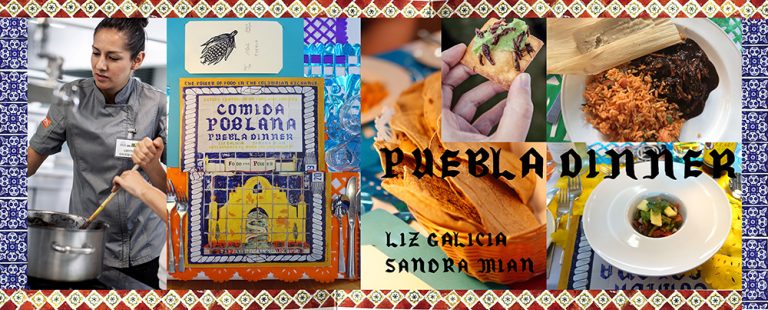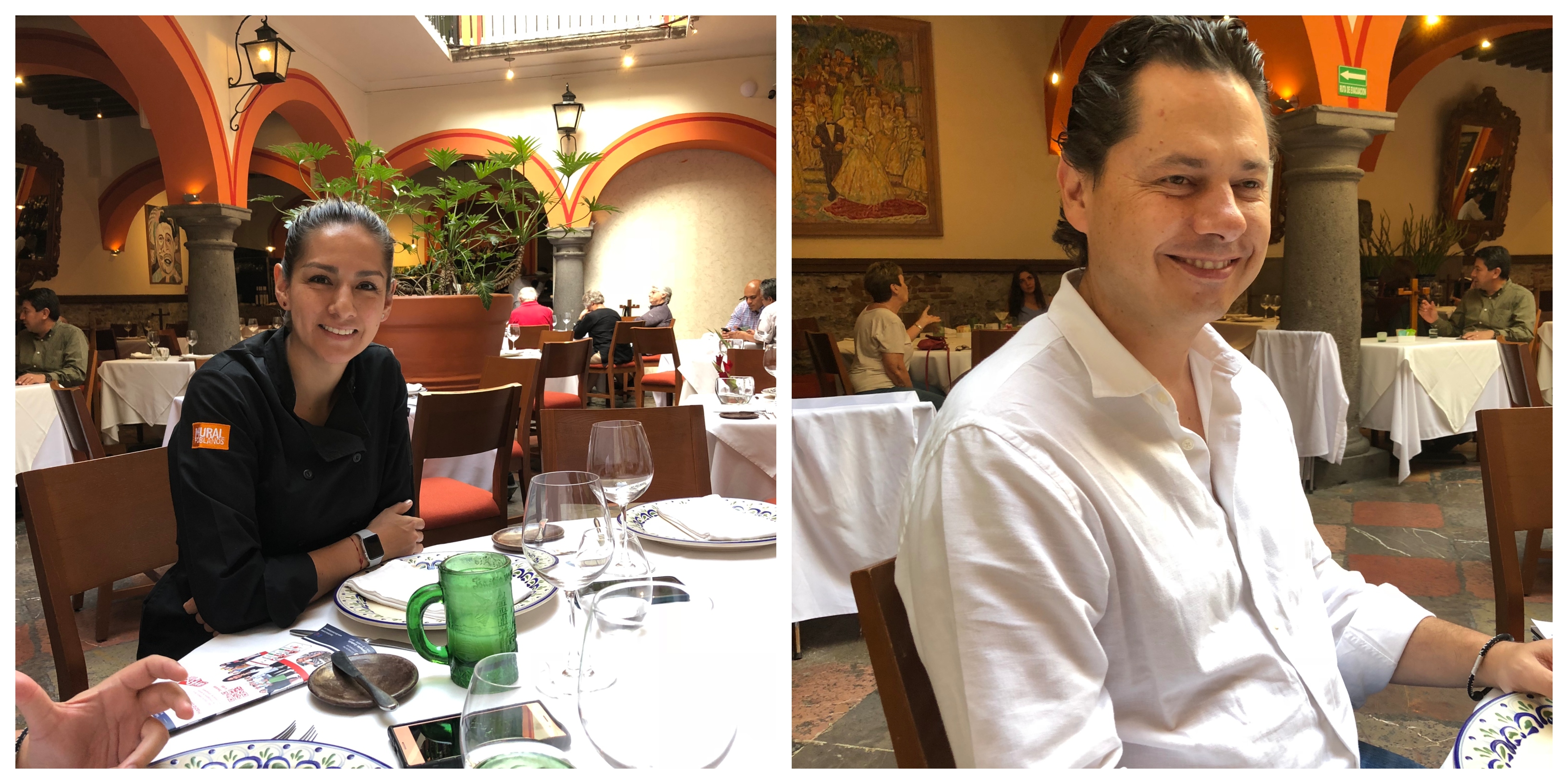
Spotlight on a Meal: The Power of Food in the Columbian Exchange

Sandra Mian describes, how during a fine dinner in Puebla, the idea of sponsoring a meal at the OFSC – Food and Power 2019 was born
May 15th 2018: it was a beautiful spring evening in Puebla de los Ángeles, the gastronomical capital of Mexico. I had been invited for dinner at one of the finest restaurants in the city, El Mural de los Poblanos. It was supposed to be a business dinner so I was prepared to present myself as a Canadian business woman. I could not, even then, have imagined that a business meal would be the starting point of an incredible adventure.
The place itself is amazing: housed in a 17th century building, with walls covered with murals – hence El Mural – depicting famous sons and daughters of Puebla. A local family has transformed what had been a Spanish-style restaurant into one of the jewels of Mexican gastronomy. Everything is local, from the handmade dishes and glasses to the ingredients, seasonal and sourced from local producers.
One of the owners, Juan-José Cue, was talking about the chef, Lisette Galicia, and how she was a proud defender of the value of traditional family recipes in a professional kitchen. That was my first big surprise of that night: that the head chef of as acclaimed restaurant was a woman! Immediately I asked him if I could talk with Lisette – Lis to those who know her well – a young woman who impressed me immediately with her knowledge and commitment. And when Lisette asked us what we would like to eat, I asked her to bring whatever she thought best.
My only request was that I wanted to drink pulque, my all-time favourite. Now it was the owners’ time to be surprised as pulque is not what foreigners usually drink. In truth, most Mexicans have never tasted it either! Pulque, the fermented sap of maguey pulquero, a member of the agave family, is a whitish and mildly alcoholic drink, the most important beverage in Mexico during prehispanic times. However, in common with amaranth, pulque suffered from the conquerors’ prejudice against prehispanic foodstuffs, and by the 1940’s, pulque had been replaced as the national refreshment of choice by beer.
Questioned as to the reason for my taste for pulque as a foreigner, I answered, as I often do in Mexico: “Nosotros, los Mexicanos, nacemos donde queremos” – We Mexicans are born wherever we choose. From that moment on I realized I was not regarded as a Brazilian or Canadian any more. Now I was truly a Mexican.
The food arrived and we started eating and drinking as Mexicans like to do: savouring each bite, talking and having fun at the table, discussing the food, its origins, the ingredients, their history. And I started to think about how much my friends of the Oxford Symposium on Food and Cookery would love to experience a meal such as this. So I spoke my thoughts aloud as they came into my head:
“What an amazing thing it would be for my fellow Symposiasts to taste mezcal and chapulines and mole and all this wonderful food, so deeply linked to the landscape and the history of Puebla.”
And the answer was: “Well, we would love to have all them here but we know it is not possible. But what if we could bring our food to Oxford?” When Mexicans introduce themselves to strangers and mention their land of origin, they also add the traditional offer of hospitality: “mi casa es su casa” – my home is your home. And they mean it! As a Mexican myself (well …adopted but Mexican anyway!), I knew my friends were serious about the offer.
After several mugs of pulque and glasses of beer and mezcal, we were all brainstorming how the gastronomy of Puebla could fit into the Symposium’s theme for 2019, ‘Food and Power’. Everyone at the table started to offer suggestions. “Puebla was very powerful during colonial times because of the commerce,” one said. Another added, “Yes, but it was because the location of Puebla midway between the ports of Acapulco and Veracruz”. As we were eating some wonderful sweetmeats while drinking a local digestif, we also remembered that power of the Catholic Church and the nuns that have created all those wonderful morsels.
My head was spinning! What if we could present a proposal to the Symposium’s Trustees suggesting Puebla as sponsor for a meal? As good Mexicans, we all said the only thing that could go wrong was that the Trustees would say ‘no’. But why not try? At first I played the devil’s advocate, setting out all the difficulties: Puebla is on the other side of the Atlantic, we may need to source hard-to-find ingredients, the logistics are not easy, and so on. But my Mexican friends always answered me with a smile: “We did much more difficult things in the past, we can do this now”.
Never doubt the tenacity of the Mexicans. In the following days and weeks, we discussed how we could have a meal that rested on three pillars: the power of landscape, the power of commerce, and – last but by no means least – the power of women. Being helped by a wonderful and very generous local historian, Fabián Valdivia, I started putting our ideas on paper.
The power of the landscape
Puebla is located on in a fertile region and the climate is very benign. Indeed, the land seemed so fertile and climate so good that the Spaniards decided to build a city so perfect that the angels themselves might have drawn up the plans. The result was Puebla de los Ángeles. The climate is much like that of Spain’s most temperate regions, neither too cold nor too hot. There was water available and the region was already famous for the vast quantity of maguey, the magical all-purpose plant so useful the first chroniclers named it the tree of wonders. At that time, pulque was the traditional alcoholic beverage, maize was the staple grainfood eaten with beans, chilies, cactus-paddles, pumpkins, avocadoes and insects such as chapulines, grasshoppers.
Before the Conquistadores arrived, the region was populated by a fiercely independent people who had never completely accepted Aztec rule. With the aid of a Nahua woman, Malintze, known as La Malinche, Hernán Cortéz joined forces with the locals and was able to defeat the Aztecs. The memory of La Malinche is preserved, appropriately for one so fiery, in the name of one of the volcanoes that rise beyond the city.
The second pillar: commerce between East and West
From 1565 to 1815, the Spanish kings established a trade route between the east and the west. Twice a year from the port of Acapulco, the Galeón de Manila sailed across the Pacific to the Philippines, carrying gold and silver but also, and maybe even more important, foodstuffs. On the return journey to Acapulco – tornaviaje – the Galeón was loaded with luxury goods such as spices, especially cinnamon and cloves. These goods were transported overland via Puebla, a city strategically located midway between the Pacific and Atlantic coasts. From Veracruz the goods were sent onwards to Spain. The return journey brought products from Europe, with Puebla serving the same function in reverse. As the commercial crossroads between East and West, Puebla became rich and powerful, developing a merchant class who could afford to use spices and exotic products in their kitchens. As a result, the dish for which Puebla is most famous, mole poblano, is the perfect example of the Columbian Exchange: a gastronomic triumph in which local and imported ingredients are perfectly harmonised through the application of both local and foreign techniques.
The third pillar: the power of women
In the time of the Spanish ascendancy, the city of Puebla was endowed with more Roman Catholic convents than any other city of New Spain. For a woman to be accepted as a nun, it was necessary to be of Spanish descent (or at least belong to one of the higher castas) and bring an acceptable dowry. Such women were educated, came with their own servants, and had ample time and money to order up the latest Spanish cookbooks and adapt the recipes to local ingredients and tastes. Many of the dishes that have now come to be associated with Mexican cuisine – mole poblano, manchamanteles, chiles en nogada – were invented in Puebla by skilled convent cooks working in the vast Talavera-tiled kitchens where they prepared the traditional convent sweetmeats sold on saints days as a source of income.
Later, during the Revolution of the early 20th century, las adelinas – women who fought alongside men – used their culinary skills to cook good food for their fellow fighters – particularly café de olla, a highly-spiced morning drink powerful enough to waken the weariest soldier and send him into battle well-fortified.
With these three ideas in mind and in spirit of los lienzos – drawings through which Aztecs and Mayas recorded their history – chef Lisette has devised a menu that tells the story of Puebla through the recipes devised in traditional households and convent kitchens.
So it came about our dream of presenting the story of Puebla as an edible history will soon become a reality: we are proud to announce that the Friday dinner at the Oxford Symposium this year will be an authentically poblano feast.
As we say to all those friends we do not yet know, and those who are already our friends: ‘Somos de Puebla y nuestra casa es su casa; nuestra comida es su comida. !Provechito!‘ – “We are from Puebla and our home is your home; our food is your food. Enjoy!”
